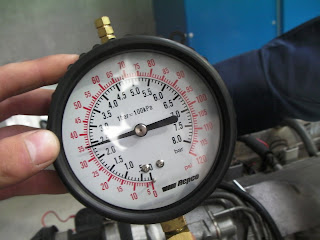Experiment
We connected a fuel pressure gauge to the fuel line after the filter. We started the engine and checked the gauge the reading was about 2.5 bar when we revved the engine the pressure increased to about 3 bar. To simulate the engine at full speed the vacuum hose can be disconnected from the fuel pressure regulator.
Reflection
The fuel pressure gauge can be used to see if the fuel pump is working and to check if the fuel pressure regulator is working properly. when the engine is idling and then the regulator vacuum hose is removed the pressure should increase in the fuel line. If it remains the same there may be a problem with the fuel pressure regulator. A flow test is done to see how much fuel is pumped out over a certain amount of time. The fuel supply pipe is disconnected and placed in a bottle or any other container then the time it takes to fill up is measured. The flow rate is equal to the amount (size of the container) divided by time (how long it takes to fill up the container)
Fuel pressure gauge
Gauge at idle speed


Good blog, can you follow this up with your experiment with the oscilloscope. What happend to the injector pulse when you disconnected the Map sensor
ReplyDeleteGood, would you Carrie out another test when you hook up the pressure Tester?
ReplyDelete